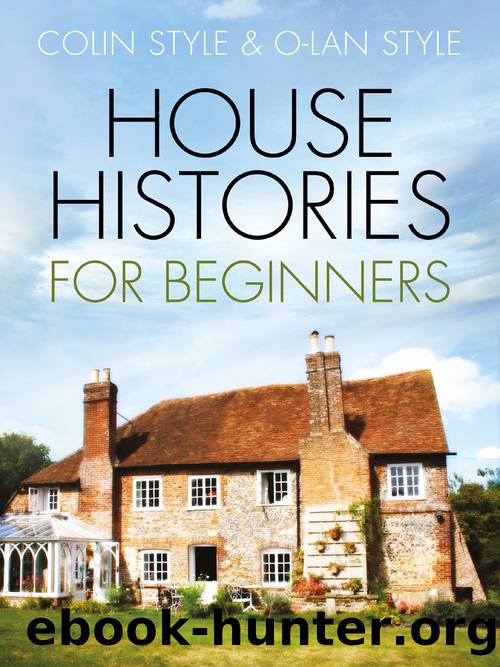House Histories for Beginners by Colin & O-lan Style

Author:Colin & O-lan Style [Style, Colin & O-lan]
Language: eng
Format: epub
Publisher: Phillimore
Farms and Domesday Book
Domesday Book is one of the universally earliest and greatest land surveys ever carried out. It is, however, of little use in the vast majority of house histories. Historic farms, nevertheless, are one property category well worth looking for in Domesday Book. A farm might be traceable to part of a Domesday manor â or, indeed, it might once have been a Domesday manor in its own right. If it still bears its Domesday name, it will be quite easily traced in the relevant volume of the English Place-Names series, published by county by the English Place-Name Society. Another place to look is the accessible Phillimore âcountyby-countyâ edition of Domesday Book, which also provides a commentary and explanation of the Domesday entries.40 The commentary is additionally useful because it may refer to later records.
Even if a farm being researched was not a manor itself, it pays to look up the manor of which it was part. Most commonly, the manor will bear the same name as the parish. It should be borne in mind, though, that a parish might once have contained a number of manors. Also, a manor could be distributed across more than a single parish.
The entry in Domesday Book can be counted on to provide details, with area specifications, of the ploughs (measure of cultivated land), pasture, woodland, underwood and meadow. Also listed is the number of various cottars, bordars, villeins, slaves, serfs, villagers and smallholders. To make any identifications with the farm and Domesday lands, it will be necessary to be familiar with the area of the whole parish today. This will need the tithe survey details as a basis, and a large modern map. A directory, like a 20th-century Kellyâs Directory, will give the total acreage of the parish and a topographical description. Armed with these, the Domesday Book descriptions of the lands can be studied and compared with todayâs lands.
Piecing it all together in this way can provide glimpses of the earliest formation of the farm. For example, was it likely to have been smallholdersâ land? Or was it part of the common pasture, or carved in the post-Domesday period from original woodland? An example of the way conclusions can be reached is provided by the case of Boswell Farm. Located in Sidford, Devon, it was believed to have been part of the manor of Sidbury in 1086. The modern name is held to be a corruption of the Old English word bosk or thicket.41 At Domesday there were 300 acres of wood in Sidbury42 and a reasonable surmise, therefore, is that the farm was once part of this wood.43
The same process of making comparisons and inferences can be applied if the farm was a complete manor in itself. Here the farm lands, past or present, form the basis of comparison with the Domesday entry.
It is just possible to make some fresh discovery about a farm in Domesday Book. An example of this is Rudway Barton, in Rewe, Devon. It had long been supposed to be the Domesday manor of âRadeweiâ.
Download
This site does not store any files on its server. We only index and link to content provided by other sites. Please contact the content providers to delete copyright contents if any and email us, we'll remove relevant links or contents immediately.
| Landmarks & Monuments | Religious Buildings |
| Residential |
Kathy Andrews Collection by Kathy Andrews(10554)
The remains of the day by Kazuo Ishiguro(7577)
Spare by Prince Harry The Duke of Sussex(4222)
Paper Towns by Green John(4178)
The Body: A Guide for Occupants by Bill Bryson(3818)
Be in a Treehouse by Pete Nelson(3235)
Harry Potter and the Goblet Of Fire by J.K. Rowling(3079)
Goodbye Paradise(2978)
Never by Ken Follett(2910)
Into Thin Air by Jon Krakauer(2712)
The Remains of the Day by Kazuo Ishiguro(2627)
The Genius of Japanese Carpentry by Azby Brown(2616)
The Cellar by Natasha Preston(2605)
Drawing Shortcuts: Developing Quick Drawing Skills Using Today's Technology by Leggitt Jim(2537)
120 Days of Sodom by Marquis de Sade(2446)
Architecture 101 by Nicole Bridge(2356)
Machine Learning at Scale with H2O by Gregory Keys | David Whiting(2319)
The Man Who Died Twice by Richard Osman(2310)
Industrial Automation from Scratch: A hands-on guide to using sensors, actuators, PLCs, HMIs, and SCADA to automate industrial processes by Olushola Akande(2130)
